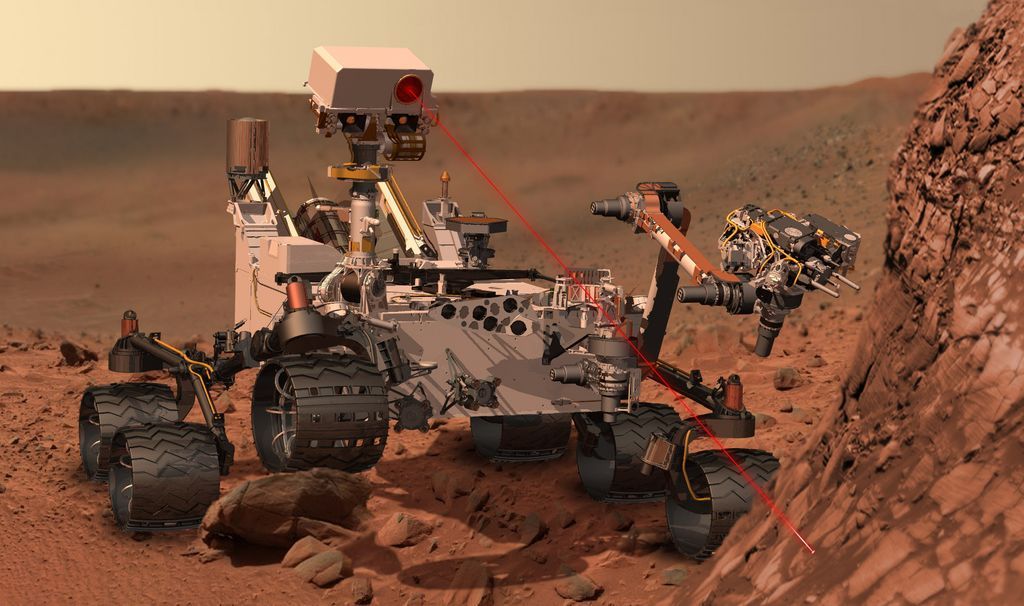Computers are getting smaller and lighter all the time. It’s a trend that pays off not only in terms of smartphones and tablets here on Earth, but in the instruments we’ve sent winging to other planets. NASA’s Mars Science Laboratory, enclosed within a vehicle the size of an S.U.V. called ‘Curiosity,’ was launched in November and should land on Mars, assuming all goes well, on August 5 of 2012. This is one big mission — it should help us find out whether Mars may have once supported life — but everything about it hinges on the very small. High-tech on Earth is enabling planetary exploration in new and powerful ways. Let’s talk about how it works.
Curiosity will be landing in a 100-mile-wide crater called Gale, where a mountain three miles high protrudes from the center. We’ve had rovers on Mars before, of course, including the tiny Sojourner, which was no bigger than a microwave oven, and the two doughty explorers Spirit and Opportunity. We’ve learned that Mars once supported rivers, lakes and possibly an ocean. Gale Crater turns out to be one of the best places on the planet to look for water and organic compounds, the building blocks that may have supported life on Mars. Curiosity’s job will be to explore the terrain around the mountain looking for these compounds in the exposed strata.
The six-wheel drive vehicle is loaded with instruments and the necessary tools for feeding them with data. Take the ChemCam. The system at work here includes a tiny laser sitting atop Curiosity’s camera mast that can vaporize a minute bit of Martian rock. Alongside the laser is the instrument’s telescope. The chosen rock surface is heated until the sample area is vaporized and becomes a glowing gas, at which point the ChemCam’s telescope feeds the resulting light to three spectrometers inside the rover that can record the light’s intensity at thousands of different wavelengths of visible, infrared and ultraviolet light. Chemical elements inside the rock all emit light at different wavelengths, allowing for a precise identification of the rock’s composition.
ChemCam’s laser can hit a pinpoint target from a distance of as much as 23 feet, bathing it in the power of a million light bulbs for five one-billionths of a second. But remember, Curiosity is a rover, one with enough mobility to climb over a two-foot obstacle even though it weighs nearly a ton, more than five times the weight of Spirit and Opportunity. If ChemCam finds something interesting, Curiosity can move in on the target to drill out an actual rock sample. Our earlier rovers have found evidence for lighter elements like carbon, but the analysis was long and painstaking. ChemCam’s tools will make element identification straightforward and fast.
Curiosity’s MastCam camera systems will view the Martian terrain from 2 meters above the surface, allowing for the selection of ChemCam’s targets as well as places where scientists would like a closer look. In all, Curiosity contains ten different science instruments targeting the question of microbial life and whether Mars was ever able to support it. The Sample Analysis at Mars package (SAM) is a small chemical laboratory that will be fed samples of the surface as well as the atmosphere, with the ability to measure organic molecules down to the level of a few parts per billion. The rover’s robotic arm contains a drill to grind rock and deliver the resulting powder to SAM and the chemical analysis instruments that support it. An x-ray instrument called CheMin can study the composition of minerals even as SAM examines volatile gases that may escape from the ancient rock. An onboard oven will heat the sample and send released vapor to the Quadrupole Mass Spectrometer (QMS), where its main constituents can be identified.
But don’t think that all of Curiosity’s work takes place on the planetary surface. Only weeks after the launch of the Mars Science Laboratory, Curiosity commenced its science mission by measuring the radiation around it in space. The Radiation Assessment Detector (RAD) will be operational on Mars as well, offering us key information about the environment future astronauts will have to pass through on their way to the Red Planet, and eventually telling us about the levels of radiation that indigenous life on Mars would have to deal with on a daily basis.
It’s a long journey to Mars, 254 days in transit and 352 million miles along Curiosity’s route, but the highest drama is reserved for journey’s end, when the spacecraft hits the atmosphere at some 13,000 miles per hour and uses an aerobraking shield to survive the descent. Although earlier rovers landed with airbags, Curiosity’s descent will be far more dramatic, and much of it will be captured on video by a small camera located on the vehicle’s main body. The lander will fire braking rockets as it descends by parachute, and will then lower the rover on a cable. When Curiosity touches down, the cable will be cut and the lander will crash some distance away.
At that point, mission controllers will presumably light cigars and the world will breathe a sigh of relief. It won’t be an easy wait, for because of the distance between Mars and the Earth this August, the news of a successful landing will take 14 minutes to reach us. But assuming all goes well, Curiosity will then begin the study of Gale Crater, powered by nuclear thermoelectric generators that will, unlike its earlier rover cousins, let this rover work full-time without hibernation for winter. The mission is slated to last two years and should include 12 miles of surface exploration, but judging from the incredible endurance of Spirit and Opportunity (the latter is still operational after almost eight years of service), this largest of all the Mars rovers may well surprise us by continuing its mission long past its due date.
The computer revolution made all this possible. Moore’s Law — stating that the number of transistors that can be placed on an integrated circuit doubles every two years — has led to huge advances in miniaturization, with consequent advantages in making products not just smaller but lighter. Any rocket engineer will tell you that the key to planetary exploration is weight, because even our most powerful rockets can only deliver so big a payload to another world. Curiosity’s ten science instruments are a marvel of engineering that compresses a full-scale science laboratory into one tightly packed roving laboratory. The results may change the way we look at life on Mars and elsewhere.









